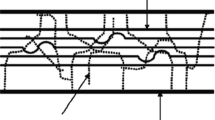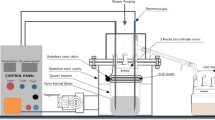Abstract
Radio-frequency (RF)-based dielectric heating was used in the alkali (NaOH) pretreatment of switchgrass to enhance its enzymatic digestibility. Due to the unique features of RF heating (i.e., volumetric heat transfer, deep heat penetration of the samples, etc.), switchgrass could be treated on a large scale, high solid content, and uniform temperature profile. At 20% solid content, RF-assisted alkali pretreatment (at 0.1 g NaOH/g biomass loading and 90°C) resulted in a higher xylose yield than the conventional heating pretreatment. The enzymatic hydrolysis of RF-treated solids led to a higher glucose yield than the corresponding value obtained from conventional heating treatment. When the solid content exceeded 25%, conventional heating could not handle this high-solid sample due to the loss of fluidity, poor mixing, and heating transfer of the samples. As a result, there was a significantly lower sugar yield, but the sugar yield of the RF-based pretreatment process was still maintained at high levels. Furthermore, the optimal particle size and alkali loading in the RF pretreatment was determined as 0.25–0.50 mm and 0.25 g NaOH/g biomass, respectively. At alkali loading of 0.20–0.25 g NaOH/g biomass, heating temperature of 90oC, and solid content of 20%, the glucose, xylose, and total sugar yield from the combined RF pretreatment and the enzymatic hydrolysis were 25.3, 21.2, and 46.5 g/g biomass, respectively.




Similar content being viewed by others
References
Dalgaard, T., Jorgensen, U., Olesen, J. E., Jensen, E. S., & Kristensen, E. S. (1998). Looking at biofuels and bioenergy. Science, 312, 1743–1743.
Chundawat, S. P. S., Venkatesh, B., & Dale, B. E. (2007). Effect of particle size based separation of milled corn stover on AFEX pretreatment and enzymatic digestibility. Biotechnology and Bioengineering, 96, 219–231.
Wyman, C. E., Dale, B. E., Elander, R. T., Holtzapple, M., Ladisch, M. R., & Lee, Y. Y. (2005). Coordinated development of leading biomass pretreatment technologies. Bioresource Technology, 96, 1959–1966.
Wyman, C. E., Dale, B. E., Elander, R. T., Holtzapple, M., Ladisch, M. R., & Lee, Y. Y. (2005). Comparative sugar recovery data from laboratory scale application of leading pretreatment technologies to corn stover. Bioresource Technology, 96, 2026–2032.
Zhao, Y. Y., Flugstad, B., Kolbe, E., Park, J. W., & Wells, J. H. (2000). Using capacitive (radio frequency) dielectric heating in food processing and preservation - A review. Journal of Food Process Engineering, 23, 25–55.
Piyasena, P., Dussault, C., Koutchma, T., Ramaswamy, H. S., & Awuah, G. B. (2003). Radio frequency heating of foods: Principles, applications and related properties - A review. Critical Reviews in Food Science, 43, 587–606.
de la Hoz, A., Diaz-Ortiz, A., & Moreno, A. (2005). Microwaves in organic synthesis: Thermal and non-thermal microwave effects. Chemical Society Reviews, 34, 164–178.
Oberndorfer, C., Pawelzik, E., & Lucke, W. (2000). Prospects for the application of dielectric heating processes in the pre-treatment of oilseeds. European Journal Lipid Science Technology, 102, 487–493.
Azuma, J., Asai, T., Isaka, M., & Koshijima, T. (1985). Enhancement of enzymatic susceptibility of lignocellulosic wastes by microwave irradiation. Journal Fermentation Technology, 63, 529–536.
Zhu, S. D., Wu, Y. X., Yu, Z. N., Chen, Q. M., Wu, G. Y., Yu, F. Q., et al. (2006). Microwave-assisted alkali pre-treatment of wheat straw and its enzymatic hydrolysis. Biosystem Engineering, 94, 437–442.
Marra, F., Lyng, J., Romano, V., & McKenna, B. (2007). Radio-frequency heating of foodstuff: Solution and validation of a mathematical model. Journal of Food Engineering, 79, 998–1006.
McKenna, B. M., Lyng, J., Brunton, N., & Shirsat, N. (2006). Advances in radio frequency and ohmic heating of meats. Journal of Food Engineering, 77, 215–229.
Marshall, M. G., & Metaxas, A. C. (1999). Radio frequency assisted heat pump drying of crushed brick. Applied Thermal Engineering, 19, 375–388.
Kaylen, M. S. (2005). An economic analysis of using alternative fuels in a mass burn boiler. Bioresource Technology, 96, 1943–1949.
Tang, J., Wang, Y., & Chan, T. V. (2004). Radio frequency heating in food processing. In: Gustavo Barbosa-Cánovas (Ed.), Novel food processing technologies, chapter 24. (pp. 501–524). Boca Raton, FL: CRC Press.
Ruiz, R., & Ehrman, T. (1996). Determination of carbohydrates in biomass by high performance liquid chromatography. In: Laboratory Analytic Procedure LAP-002. National Renewable Energy Laboratory (NREL), Golden, CO.
Ghose, T. K. (1987). Measurement of cellulase activities. Pure and Applied Chemistry, 59, 257–268.
Ruiz, R., & Ehrman, T. (1996). Determination of acid-insoluble lignin in biomass. In: Laboratory Analytic Procedure LAP-003. National Renewable Energy Laboratory (NREL), Golden, CO.
Adler, P. R., Sanderson, M. A., Boateng, A. A., Weimer, P. I., & Jung, H. J. G. (2006). Biomass yield and biofuel quality of switchgrass harvested in fall or spring. Agronomy Journal, 98, 1518–1525.
Dien, B. S., Jung, H. J. G., Vogel, K. P., Casler, M. D., Lamb, J. F. S., Iten, L., et al. (2006). Chemical composition and response to dilute-acid pretreatment and enzymatic saccharification of alfalfa, reed canarygrass, and switchgrass. Biomass Bioenergy, 30, 880–891.
Fike, J. H., Parrish, D. J., Wolf, D. D., Balasko, J. A., Green, J. T., Rasnake, M., et al. (2006). Long-term yield potential of switchgrass-for-biofuel systems. Biomass Bioenergy, 30, 198–206.
Fike, J. H., Parrish, D. J., Wolf, D. D., Balasko, J. A., Green, J. T., Rasnake, M., et al. (2006). Switchgrass production for the upper southeastern USA: Influence of cultivar and cutting frequency on biomass yields. Biomass Bioenergy, 30, 207–213.
Yang, B., & Wyman, C. E. (2004). Effect of xylan and lignin removal by batch and flowthrough pretreatment on the enzymatic digestibility of corn stover cellulose. Biotechnology and Bioengineering, 86, 88–95.
Mansfield, S. D., Mooney, C., & Saddler, J. N. (1999). Substrate and enzyme characteristics that limit cellulose hydrolysis. Biotechnology Progress, 15, 804–816.
Acknowledgment
This work is supported by USDA CSREES (2006-38909-03484).
Author information
Authors and Affiliations
Corresponding author
Rights and permissions
About this article
Cite this article
Hu, Z., Wang, Y. & Wen, Z. Alkali (NaOH) Pretreatment of Switchgrass by Radio Frequency-based Dielectric Heating. Appl Biochem Biotechnol 148, 71–81 (2008). https://doi.org/10.1007/s12010-007-8083-1
Received:
Accepted:
Published:
Issue Date:
DOI: https://doi.org/10.1007/s12010-007-8083-1




